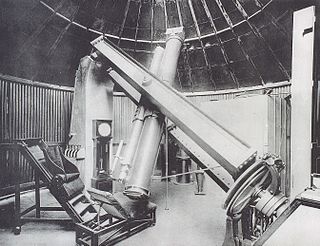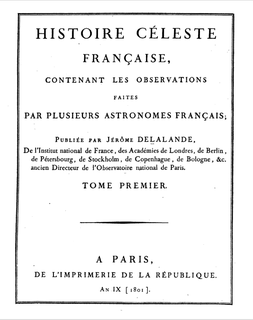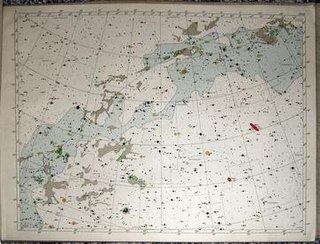 W
WA star catalogue or star catalog, is an astronomical catalogue that lists stars. In astronomy, many stars are referred to simply by catalogue numbers. There are a great many different star catalogues which have been produced for different purposes over the years, and this article covers only some of the more frequently quoted ones. Star catalogues were compiled by many different ancient people, including the Babylonians, Greeks, Chinese, Persians, and Arabs. They were sometimes accompanied by a star chart for illustration. Most modern catalogues are available in electronic format and can be freely downloaded from space agencies' data centres. The largest is being compiled from the Gaia (spacecraft) and thus far has over a billion stars.
 W
WA star chart or star map, also called a sky chart or sky map, is a map of the night sky. Astronomers divide these into grids to use them more easily. They are used to identify and locate constellations and astronomical objects such as stars, nebulae, and galaxies. They have been used for human navigation since time immemorial. Note that a star chart differs from an astronomical catalog, which is a listing or tabulation of astronomical objects for a particular purpose. Tools utilizing a star chart include the astrolabe and planisphere.
 W
WIda Barney was an American astronomer, best known for her 22 volumes of astrometric measurements on 150,000 stars. She was educated at Smith College and Yale University and spent most of her career at the Yale University Observatory. She was the 1952 recipient of the Annie J. Cannon Award in Astronomy.
 W
WThe Book of Fixed Stars is an astronomical text written by Abd al-Rahman al-Sufi (Azophi) around 964. Following the translation movement in the 9th Century AD, the book was written in Arabic, the common language for scholars across the vast Islamic territories, although the author himself was Persian. It was an attempt to create a synthesis of the comprehensive star catalogue in Ptolemy’s Almagest with the indigenous Arabic astronomical traditions on the constellations. The original manuscript no longer survives as an autograph, however, the importance of tradition and the practice of diligence central to Islamic manuscript tradition, has ensured the survival of the Book of Stars in later-made copies.
 W
WThe Carte du Ciel and the Astrographic Catalogue were two distinct but connected components of a massive international astronomical project, initiated in the late 19th century, to catalogue and map the positions of millions of stars as faint as 11th or 12th magnitude. Twenty observatories from around the world participated in exposing and measuring more than 22,000 (glass) photographic plates in an enormous observing programme extending over several decades. Despite, or because of, its vast scale, the project was only ever partially successful – the Carte du Ciel component was never completed, and for almost half a century the Astrographic Catalogue part was largely ignored. However, the appearance of the Hipparcos Catalogue in 1997 has led to an important development in the use of this historical plate material.
 W
WThe Ecliptic Plane Input Catalog is a publicly searchable database of stars and planets that is associated with the K2 "Second Light" plan of the Kepler space telescope mission. Examples of related stars include: EPIC 201563164, EPIC 204278916, EPIC 204376071 and EPIC 249706694. Examples of related planets include: EPIC 203771098 b, EPIC 203771098 c, EPIC 206011691 c and EPIC 211945201 b.
 W
WHistoire Céleste Française is an astrometric star catalogue published in 1801 by the French astronomer Jérôme Lalande and his staff at the Paris Observatory. This star catalog consists of the locations and apparent magnitudes of 47,390 stars, up to magnitude 9. Stars are identified by common name, Bayer designation or Flamsteed designation, when available. It also contains observations of other astronomical phenomena. It was the largest and most complete star catalog of its day. This publication is a collection of several books of astronomical recordings taken over the previous decade at the observatory.
 W
WProdromus Astronomiae is a star catalog created by Johannes Hevelius and published posthumously by his wife and research aid Elisabeth Hevelius in 1690. The catalog consists of the location of 1,564 stars listed by constellation. It consists of three separate parts: a preface, a star catalog, and an atlas of constellations.
 W
WThe Skalnaté Pleso Atlas of the Heavens is a set of 16 celestial charts covering the entire sky. It is named after the Skalnaté Pleso Observatory in Slovakia where it was produced. The first versions were published by the Czechoslovak Astronomical Society in 1948; later that year, Sky Publishing Corporation acquired the copyright and began publication in the United States. The charts were hand-drawn by Antonín Bečvář.
 W
WThe Washington Double Star Catalog, or WDS, is a catalog of double stars, maintained at the United States Naval Observatory. The catalog contains positions, magnitudes, proper motions and spectral types and has entries for 141,743 pairs of double stars. The catalog also includes multiple stars. In general, a multiple star with n components will be represented by entries in the catalog for n-1 pairs of stars.